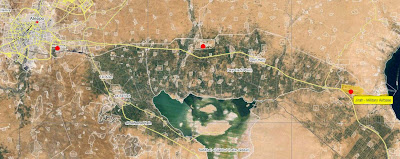 |
| ISIS fighter with destroyed Syrian Air Force MiG-21 at Tabaqah air base |
There are numerous press reports citing ISIS claims and even eyewitness reports of captured Syrian Air Force fighter aircraft being piloted by Islamic State (Islamic State in Iraq and Syria, ISIS) members. There is even a video (below), posted on YouTube that purports to be an ISIS-piloted aircraft landing at a Syrian air base that is now under ISIS control.
My translation of the header and caption that accompanied the original video post:
- Header: Exclusive first video of a MiG aircraft of the Islamic State landing at Jirah air base in Aleppo (province).
- Text: A MiG aircraft seized by the Islamic State flew three training sorties at a low altitude yesterday at dusk near Jirah air base, also called Kashaysh, which is about 70 kilometers east of Aleppo (city) in the first use of this aircraft.
As the text indicates, Jirah air base is located about 45 miles east of the city of Aleppo. It is one of three air bases formerly used by the Syrian Air Force for jet flight training. I have annotated the bases on the map - Jirah is the furthest east of the three.
 |
| Syrian Air Force jet training bases west to east: Nayrab, Rasm al'-Abud and Jirah |
All three of these training bases are either under ISIS control or are under siege. Although it would not be uncommon for MiG fighter aircraft to be at these bases, the primary aircraft used at these three bases was the Czech-built L-39 Albatros trainer.
The L-39 is also an excellent counterinsurgency aircraft - armed with a machine gun pack and rocket launchers - and was used to great effect by the Syrian Air Force in the early stages of the war. At least one of these aircraft was shot down by the Free Syrian Army.
.jpg) |
| Syrian Air Force L-39ZA firing rockets near Aleppo - 2012 |
According to the media accounts, former Iraqi Air Force pilots are training ISIS members to pilot MiG aircraft seized at captured Syrian air bases. The Iraqi pilots would be familiar with the L-39 trainer, as well as the MiG-21 and MiG-23 fighters - all three were in the Iraqi inventory years ago.
What is confusing to me is why the Iraqis are training other ISIS members to fly the aircraft - why don't they just fly them? Training a new pilot takes time, whereas a former pilot would only need to re-familiarize himself with the aircraft and ensure that the required rehabilitation and maintenance has been accomplished.
 |
| Syrian Air Force Mig-21 (top) and MiG-23 (bottom) |
Although there is a chance that there were MiG fighters at the three jet training bases, it is more likely that if ISIS has obtained either MiG-21 or MiG-23 fighters as claimed, they were probably seized at Tabaqah air base outside the self-proclaimed ISIS capital city of al-Raqqah.
The Syrians have consistently removed operational aircraft from bases about to be lost to either Free Syrian Army or ISIS, especially fighter aircraft. Most of the MiG aircraft at Tabaqah appear to be beyond repair, however, there were a few L-39 trainers at Jirah that may have been repairable.
Let's assume for the sake of discussion that ISIS has acquired a few operational jets - I have seen the number three in the media. The MiG-21 is considered a second-generation jet fighter, and the MiG-23 is considered third-generation. Neither one is in the same category as the fourth-generation aircraft being flown by the coalition or the state-of-the-art fifth-generation U.S. Air Force F-22 Raptor. While any jet fighter can theoretically pose a threat to coalition aircraft, we are not sure if ISIS is in possession of any air-to-air or air-to-ground weapons for the aircraft.
Coalition aircraft operating over Iraq and Syria are supported by a variety of intelligence, surveillance and reconnaissance aircraft and assets to provide warning of any threat posed by Syrian, and now ISIS, forces. Should an ISIS fighter aircraft - or a Syrian fighter, for that matter - attempt to engage a coalition aircraft, it will likely be detected early and dealt with. The pilots of the U.S. Air Force and U.S. Navy are quite skilled at downing Russian-made aircraft, as demonstrated on numerous occasions over the years.
That said, why wait for an engagement? We know where the Syrian air bases are, and we know which are in the hands of ISIS. These are large, fixed targets - put them out of commission. Problem solved.
Surely I am not the only one who has thought of that....


.jpg)
